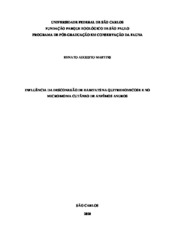| dc.contributor.author | Martins, Renato Augusto | |
| dc.date.accessioned | 2020-08-20T11:38:47Z | |
| dc.date.available | 2020-08-20T11:38:47Z | |
| dc.date.issued | 2020-05-15 | |
| dc.identifier.citation | MARTINS, Renato Augusto. Influência da desconexão de habitats na quitridiomicose e no microbioma cutâneo de anfíbios anuros. 2020. Dissertação (Mestrado em Conservação da Fauna) – Universidade Federal de São Carlos, São Carlos, 2020. Disponível em: https://repositorio.ufscar.br/handle/ufscar/13173. | * |
| dc.identifier.uri | https://repositorio.ufscar.br/handle/ufscar/13173 | |
| dc.description.abstract | Habitat split can be defined as the human-induced discontinuity between habitats used by different stages of the life history of a species. The main affected species are those that need to migrate between distinct habitats to complete their reproductive cycle, as most amphibians species. Much of the ongoing amphibian declines around the world, including Brazil, are based on the emergence of the waterborne chytrid fungus Batrachochytrium dendrobatidis (Bd). Although it is already known that habitat split is linked to an increased risk of local amphibian declines and extinctions, little is known how habitat split at the landscape scale increases the risk of chytridiomycosis. It is also known that the symbiotic cutaneous microbiota (the microbiome) is the first line of amphibians defenses against invasive pathogens such as Bd. Thus, disturbance in the cutaneous microbiome caused by deforestation and habitat fragmentation could reduce host defenses against Bd in highly fragmented landscapes. This study aims to test the effect of deforestation and habitat split on host-pathogen dynamics in amphibians, also investigating the relations between the amphibian microbiome diversity, composition, and habitat disturbances. Our results support the hypothesis that, the smaller the fragment and the more disconnected from permanent water bodies, the greater the Bd prevalence and infection loads in amphibian populations, regardless of amphibian reproductive strategy or migratory behavior. In addition, we found that high bacterial richness in the host skin microbiome is correlated with low Bd infections. Our findings highlight that efforts to restore natural riparian vegetation could reduce the risk of chytridiomycosis and contribute to the conservation of amphibians in the Atlantic Forest. | eng |
| dc.description.sponsorship | Outra | por |
| dc.language.iso | por | por |
| dc.publisher | Universidade Federal de São Carlos | por |
| dc.rights | Attribution-NonCommercial-NoDerivs 3.0 Brazil | * |
| dc.rights.uri | http://creativecommons.org/licenses/by-nc-nd/3.0/br/ | * |
| dc.subject | Batrachochytrium dendrobatidis | por |
| dc.subject | Fragmentação de habitat | por |
| dc.subject | Microbiota | por |
| dc.subject | Chytridiomycosis | eng |
| dc.subject | Microbiome | eng |
| dc.subject | Habitat split | eng |
| dc.title | Influência da desconexão de habitats na quitridiomicose e no microbioma cutâneo de anfíbios anuros | por |
| dc.title.alternative | Influence of habitat split on chytridiomycosis and cutaneous microbiome of anuran amphibians | eng |
| dc.type | Dissertação | por |
| dc.contributor.advisor1 | São Pedro, Vinícius de Avelar | |
| dc.contributor.advisor1Lattes | http://lattes.cnpq.br/7404103190291423 | por |
| dc.contributor.advisor-co1 | Becker, Carlos Guilherme | |
| dc.contributor.advisor-co1Lattes | http://lattes.cnpq.br/2671687762419507 | por |
| dc.description.resumo | A desconexão de habitats pode ser definida como a descontinuidade entre habitats usados por diferentes estágios da história de vida de uma espécie. As principais espécies afetadas são as que necessitam migrar entre habitats distintos para completar o ciclo reprodutivo, como boa parte das espécies de anfíbios. Grande parte do declínio das populações de anfíbios no mundo e no Brasil tem base na disseminação do fungo quitrídio aquático Batrachochytrium dendrobatidis (Bd). Embora já se saiba que a desconexão de habitats está ligada a um maior risco de extinção de anfíbios, um possível efeito da perda de conectividade a nível de paisagem aumentando o risco de quitridiomicose precisa ser investigado. Sabe-se também que a microbiota cutânea simbionte (o microbioma) é a primeira linha de defesas dos anfíbios contra patógenos invasores como o Bd. Desta forma, um distúrbio no microbioma cutâneo causado pelo desmatamento e fragmentação de habitats poderia reduzir as defesas dos anfíbios hospedeiros contra Bd em paisagens altamente fragmentadas. Este estudo tem como objetivo testar o efeito do desmatamento e da desconexão de habitats na dinâmica patógeno-hospedeiro em anfíbios, investigando também, as relações entre a diversidade e a composição do microbioma cutâneo dos anfíbios com a fragmentação florestal. Nossos resultados sustentam a hipótese de que, quanto menor o fragmento e mais desconectado de corpos d’água permanentes, maior a prevalência e a carga de infecção de Bd nas populações de anfíbios, principalmente em anfíbios com fase larval aquática que conduzem migrações reprodutivas durante o período chuvoso. Nossos resultados também indicam que elevada riqueza bacteriana do microbioma está correlacionada com um menor risco de quitridiomicose. Estratégias de restauração das matas ciliares podem reduzir o risco de quitridiomicose e contribuir na conservação dos anfíbios da Mata Atlântica. | por |
| dc.publisher.initials | UFSCar | por |
| dc.publisher.program | Programa de Pós-Graduação em Conservação da Fauna - PPGCFau | por |
| dc.subject.cnpq | CIENCIAS BIOLOGICAS::ZOOLOGIA::ZOOLOGIA APLICADA::CONSERVACAO DAS ESPECIES ANIMAIS | por |
| dc.publisher.address | Câmpus São Carlos | por |
| dc.contributor.authorlattes | http://lattes.cnpq.br/4283252154576866 | por |


